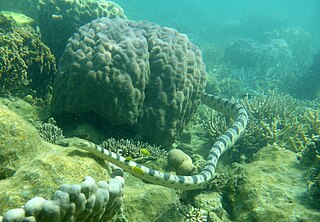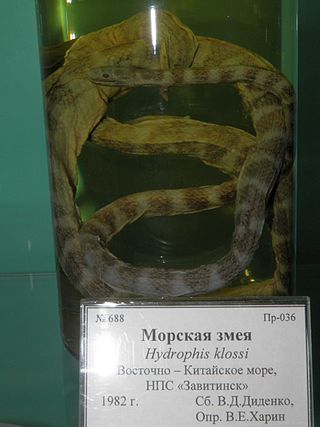
Stokes's sea snake is a large species of sea snake in the family Elapidae. It is sometimes placed in its own genus Astrotia. The species is endemic to tropical Indo-Pacific oceanic waters.

The olive-headed sea snake, also known as the greater sea snake, is a species of venomous sea snake in the family Elapidae.

Hydrophis caerulescens, commonly known as the dwarf sea snake, is a species of venomous sea snake in the family Elapidae.

Hydrophis cyanocinctus, commonly called the annulated sea snake or the blue-banded sea snake, is a species of venomous sea snake in the family Elapidae.

Hydrophis klossi, commonly known as Kloss's sea snake, is a species of sea snake in the family Elapidae. Like all other sea snakes, it is venomous. The species is endemic to the Indian Ocean.
Hydrophis stricticollis, commonly called the collared sea snake, is a species of venomous sea snake in the family Elapidae.

Jerdon's sea snake is a species of venomous sea snake in the subfamily Hydrophiinae.

The spine-bellied sea snake, also commonly known as Hardwicke's sea snake and Hardwicke's spine-bellied sea snake, is a species of venomous sea snake in the family Elapidae. The species is native to the Indian Ocean and the western Pacific Ocean.

Günther's black snake is a species of poorly known lamprophiid snake endemic to central Africa. It is the only member of the genus, Bothrolycus. This snake is notable as one of the few snakes with notable sexual dimorphism, as well as possessing a small pit anterior to the eye. While superficially similar to the thermal pits of vipers, its function remains unknown.
Hypoptophis is a monotypic genus created for the rear-fanged (opisthoglyphous) mildly venomous snake species, Hypoptophis wilsonii. The species, which is endemic to Africa, is in the subfamily Aparallactinae of the family Atractaspididae. There are no subspecies that are recognized as being valid.

Macrelaps is a monotypic genus created for the rear-fanged (opisthoglyphous) venomous snake species, M. microlepidotus, endemic to South Africa. No subspecies are currently recognised.
The Cameroon racer, Poecilopholis cameronensis, is a species of rear-fanged mildly venomous snake endemic to Africa. Poecilopholis is a monotypic genus created for this species.
Micrelaps boettgeri, commonly known as Boettger's two-headed snake, is a species of mildly venomous rear-fanged snake in the family Atractaspididae. The species is endemic to Africa.
Polemon barthii, or the Guinea snake-eater, is a species of rear-fanged mildly venomous snake in the family Atractaspididae. The species is endemic to Africa.
Polemon christyi, also known commonly as Christy's snake-eater and the eastern snake-eater, is a species of mildly venomous rear-fanged snake in the subfamily Aparallactinae of the family Atractaspididae. The species is native to Central Africa and East Africa.
Polemon gracilis, or the graceful snake-eater, is a species of mildly venomous rear-fanged snake in the family Atractaspididae. It is endemic to Africa.
Aparallactus jacksonii, or Jackson's centipede-eater, is a species of mildly venomous rear-fanged snake in the family Atractaspididae.

Aparallactus modestus, or the western forest centipede-eater, is a species of mildly venomous rear-fanged snake in the Atractaspididae family.
Aparallactus nigriceps, or the Mozambique centipede-eater, is a species of mildly venomous rear-fanged snake in the family Atractaspididae.
Aparallactus werneri, or the Usambara centipede-eater, is a species of mildly venomous rear-fanged snake in the family Lamprophiidae. The species is endemic to Tanzania.










